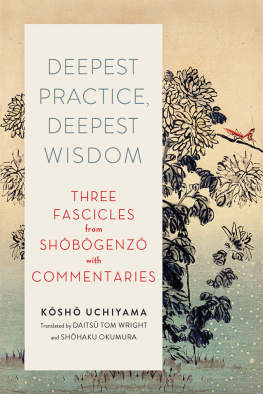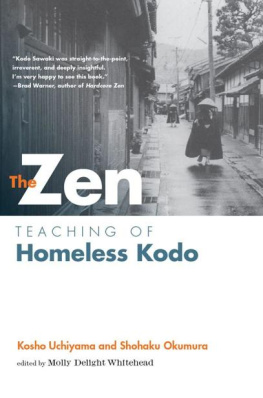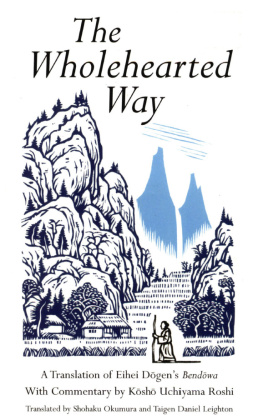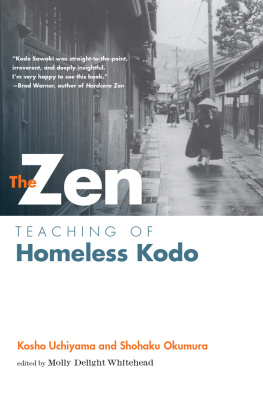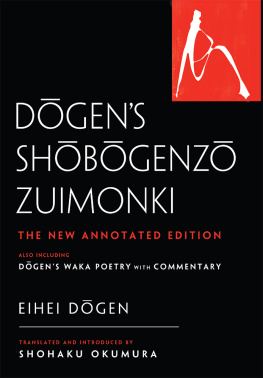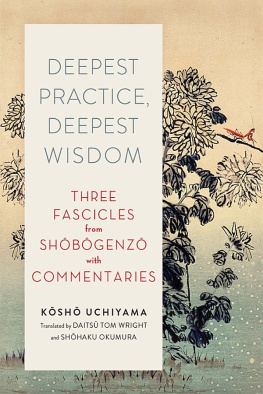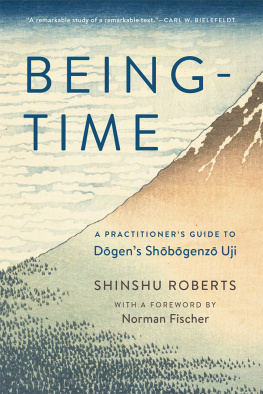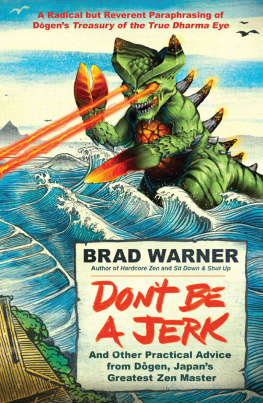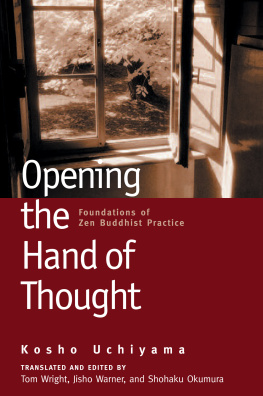A magnificent gift for anyone interested in the deep, clear waters of Zenits great foundational master coupled with one of its finest modern voices.
JISHO WARNER, former president of the Soto Zen Buddhist Association
FAMOUSLY INSIGHTFUL AND FAMOUSLY COMPLEX, Eihei Dgens writings have been studied and puzzled over for hundreds of years. In Deepest Practice, Deepest Wisdom, Ksh Uchiyama, beloved twentieth-century Zen teacher, addresses himself head-on to unpacking Dgens wisdom from three fascicles (or chapters) of his monumental Shbgenz for a modern audience.
The fascicles presented here from Shbgenz, or Treasuryof the True Dharma Eye, include Shoaku Makusa or Refraining from Evil, Maka Hannya Haramitsu or Practicing Deepest Wisdom, and Uji or Living Time. Daits Tom Wright and Shhaku Okumura lovingly translate Dgens penetrating words and Uchiyamas thoughtful commentary on each piece.
At turns poetic and funny, always insightful, this is Zen wisdom for the ages.
KSH UCHIYAMA was a preeminent Japanese Zen master instrumental in bringing Zen to America. The author of over twenty books, including Opening the Hand of Thought and The Zen Teaching of Homeless Kodo, he died in 1998.
Introduction
Interest in Buddhist thought and practice has grown immensely during the past thirty or forty years. Zen Buddhism in particular has caught the eye of scholars in Western philosophy and ethics and also of ordinary people (nonspecialists), young and old alike. Among exponents of Zen thought, enthusiasm has centered on the writings of the great thirteenth-century Japanese Zen master Eihei Dgen (). Dgen was not the first to talk about Zen in Japan, but his complete devotion to explicating the teachings of the Buddha and putting those teachings into action left a most impressive legacy for many generations following. Dgen also coined many expressions and wrote in a style that has had a lasting influence on the Japanese language. Dgens ideas were revolutionary, fresh, and thoroughly rooted in the Buddhas teachings.
Today, more and more translations of Dgens works are emerging, as well as commentaries on the depth of his teachings. If scholars find this book helpful, that is fine, but if this book were only for scholars, then the audience would indeed be a small one. It is my sincere hope that this book will be most helpful to anyone who raises the questions Who am I? or What is all of this around me? or How can we be free of suffering?
A Brief History of Dgens Life
Eihei Dgen lived during the Kamakura period (, 11851333) in Japan. Only fifteen years prior to Dgens birth, the emperor was overthrown and a military government called the bakufu took over. The military government controlled most or all of Japan for the next several hundred years with frequent conflicts and battles between clans and classes. Dgens father died when he was three years old, and his mother died when he was seven. So he was orphaned as a child and lost several relatives due to military conflict. Thus, it was in no ideal state of calm and peace that Dgen surely carried within himself the questions of Who am I? What is all this? and How can we be free from suffering?
At thirteen years of age, young Dgen was ordained as a novice priest on Mt. Hiei in the Tendai tradition. At Mt. Hiei, he studied the Lotus Stra extensively, which led to the question if we are already enlightened, why do we have to practice? Dgens teachers were unable to answer him and advised him to visit Eisai Zenji, abbot of Kenninji monastery in the capital, Miyako. Eisai had returned from China a few years earlier and had brought the Zen teaching with him to Japan. Whether Dgen actually met Eisai Zenji or not and was invited to visit the abbots room at any time.
On one occasion at the monastery, Dgen presented his dilemma to Nyoj, who had now become his teacher. If we are all enlightened, as is written in the Lotus Stra, why do we need to practice? Nyojs reply turned Dgens life around. He said that practice is a manifestation of enlightenment. In other words, the practice of zazen was not something one did in order to gain enlightenment; rather, sitting itself fully manifests enlightenment and the Buddhas teaching.
Dgen returned from China in 1227 or 1228 and reentered Kenninji Monastery, where he lived for three more years. But, from a few brief statements among his writings, we understand that he was very disappointed in the collapse of the practice there and left.
Dgen then lived in a small hermitage southeast of Miyako, present-day Kyoto. Finally, in 1233, Dgen was able to found his first temple, Kannon-dri Ksh Hrinji in Fukakusa, a district south of the city of Kyoto. This is not the same Kshji monastery that is today located on the north side of the Uji River across from Byd-in Temple in the city of Uji. The former burned down after Dgen moved to Echizen, in todays Fukui Prefecture, and was rebuilt in Uji in the seventeenth century.
As kan practice was gaining in strength and popularity in Miyako, and as increasing criticism came from Mt. Hiei, Dgen decided to leave the area of the capital completely and move to the countryside. So, in 1243, Dgen left Kshji and made the arduous journey to the province of Echizen. The following year, he moved into Daibutsuji Monastery. Later, Daibutsuji was renamed Eiheiji, and it was there that Dgen spent his final ten years of teaching. In 1253, Dgen fell ill and decided to seek treatment in Miyako. When he left Eiheiji, Koun Ej () became the next abbot. After his arrival in the capital and a brief stay at the home of a lay follower, Dgen passed away.
Dgens Writing Style
Dgen wrote in a Japanese as far removed from the present-day language as Chaucers work is from modern English. His writing style is incisive and also very poetic. He used metaphors and hyperbole, as well as Zen mondo or kans in his writings. Dgen often quoted from various scriptures, many times tweaking them with his own turn of phrase. He also coined many new words to express his vision of Buddhadharma. It takes several readings to even begin to grasp the connection of Dgens writing to our practice, but the effort is worth it; every reading deepens ones understanding. As Alexander Pope says: A little learning is a dangerous thing, drink deeply, or taste not the Pierian spring, for shallow draughts intoxicate the brain, and drinking largely sobers us again. In fact, even having much knowledge about something is incomplete unless it can come to function in our day-to-day life through wisdom. And the way to begin to unfold the many layers of the teaching of Buddhadharma as wisdom is to practice it.
Context for the Chapters
Each part in this book will begin with a fascicle from Dgen Zenjis Shbgenz. Next, there will be a commentary by Ksh Uchiyama Rshi. The fourth section of the book is comprised of comments from the translators.
All of Uchiyama Rshis remarks were derived from Dharma talks he gave at Ssenji Temple in Kyoto at the monthly zazen gatherings there between 1978 and 1988, after Uchiyama Rshis retirement as abbot of Antaiji Monastery in 1975. The talks were at the invitation of then-abbot Hosokawa Yh Rshi and recorded and later transcribed by Ishiguro Bunichi. The transcriptions were then edited and published by Hakujusha Publishers, Tokyo, in the volumes Shbgenz: Appreciating Makahannya-Haramitsu, Ikka no Myju, and Sokushin Zebutsu ( //); ) in 1982 and in 1984 Shbgenz: Appreciating Uji and Shoaku Makusa ( / ).
The first fascicle in this book is Maka Hannya Haramitsu (, Practicing Deepest Wisdom), Dgens commentary or teaching on the

